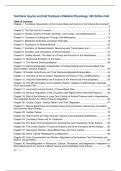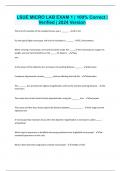Test Bank Guyton and Hall Textbook of Medical Physiology 14th Edition Hall
Table of Contents
Chapter 1. Functional Organization of the Human Body and Control of the“Internal Environment”
..................................................................................................................................................... 4
Chapter 2. The Cell and Its Functions .......................................................................................... 6
Chapter 3. Genetic Control of Protein Synthesis, cell function, and cellreproduction ................... 9
Chapter 4. Transport of Substances Through Cell Membranes.................................................. 12
Chapter 5. Membrane Potentials and Action Potentials.............................................................. 16
Chapter 6. Contraction of Skeletal Muscle ................................................................................. 22
Chapter 7. Excitation of Skeletal Muscle: Neuromuscular Transmission and ............................. 27
Chapter 8. Excitation and Contraction of Smooth Muscle .......................................................... 31
Chapter 9. Cardiac Muscle; The Heart as a Pump and Function of the HeartValves ................. 33
Chapter 10. Rhythmical Excitation of the Heart .......................................................................... 35
Chapter 11. The Normal Electrocardiogram ............................................................................... 38
Chapter 12. Electrocardiographic Interpretation of Cardiac Muscle and Coronary Blood Flow
Abnormalities: Vectorial Analysis ................................................................................................ 39
Chapter 13.Cardiac Arrhythmias and Their ElectrocardiographicInterpretation .......................... 44
Chapter 14. Overview of the Circulation; Biophysics of Pressure, Flow, andResistance ............ 48
Chapter 15. Vascular Distensibility and Functions of the Arterial and VenousSystems .............. 50
Chapter 16. The Microcirculation and Lymphatic System: Capillary FluidExchange, Interstitial
Fluid, and Lymph Flow................................................................................................................ 53
Chapter 17. Local and Humoral Control of Tissue Blood Flow ................................................... 56
Chapter 18. Nervous Regulation of the Circulation and Rapid Control ofArterial Pressure ........ 59
Chapter 19. Role of the Kidneys in Long-Term Control of Arterial Pressure and in Hypertension:
The Integrated System for Aterial Pressure Regulation .............................................................. 62
Chapter 20. Cardiac Output, Venous Return, and Their Regulation........................................... 67
Chapter 21. Muscle Blood Flow and Cardiac Output During Exercise; theCoronary Circulation
and Ischemic Heart Disease ....................................................................................................... 70
Chapter 22. Cardiac Failure ....................................................................................................... 72
Chapter 23. Heart Valves and Heart Sounds; Valvular and Congenital HeartDefects ................ 75
Chapter 24. Circulatory Shock and Its Treatment....................................................................... 77
Chapter 25. The Body Fluid Compartments: Extracellular and Intracellular Fluids; Edema........ 80
Chapter 26. The Urinary System: Functional Anatomy and Urine Formation by the Kidneys ..... 80
Chapter 27. Glomerular Filtration, Renal Blood Flow, and Their Control .................................... 80
Chapter 28. Renal Tubular Reabsorption andSecretion ............................................................. 80
Chapter 29. Urine Concentration and Dilution; Regulation of Extracellular Fluid Osmolarity and
Sodium Concentration ................................................................................................................ 80
Chapter 30. RenalRegulation of Potassium, Calcium, Phosphate, and Magnesium; Integration of
Renal Mechanisms for Control of Blood Volume and Extracellular Fluid Volume ....................... 80
1|Page
,Chapter 31. Acid-Base Regulation .............................................................................................. 80
Chapter 32. Diuretics, Kidney Diseases ..................................................................................... 91
Chapter 33. Red Blood Cells, Anemia, and Polycythemia .......................................................... 94
Chapter 34. Resistance of the Body to Infection: I. Leukocytes, Granulocytes,the Monocyte-
Macrophage System, and Inflammation ...................................................................................... 97
Chapter 35. Resistance of the Body to Infection: II. Immunityand Allergy .................................. 99
Chapter 36. Blood Types; Transfusion; Tissue and Organ Transplantation ............................... 99
Chapter 37. Hemostasis and Blood Coagulation ...................................................................... 102
Chapter 38. Pulmonary Ventilation ........................................................................................... 104
Chapter 39. Pulmonary Circulation, Pulmonary Edema, Pleural Fluid ...................................... 107
Chapter 40. Principles of Gas Exchange; Diffusion of Oxygen and CarbonDioxide Through the
Respiratory Membrane ............................................................................................................. 110
Chapter 41. Transport of Oxygen and Carbon Dioxide in Blood and TissueFluids................... 113
Chapter 42. Regulation of Respiration ..................................................................................... 117
Chapter 43. Respiratory Insufficiency – Pathophysiology, Diagnosis, OxygenTherapy ............ 120
Chapter 44. Aviation, High Altitude, and Space Physiology...................................................... 122
Chapter 45. Physiology of Deep-Sea Diving and Other Hyperbaric.......................................... 125
Chapter 46. Organization of the Nervous System, Basic Functions ofSynapses, and
Neurotransmitters ..................................................................................................................... 128
Chapter 47. Sensory Receptors, Neuronal Circuits for Processing Information ....................... 130
Chapter 48. Somatic Sensations: I. General Organization, the Tactile andPosition Senses ..... 133
Chapter 49. Somatic sensations: II. Pain, Headache, and Thermal Sensations ....................... 136
Chapter 50. The Eye: I. Optics of Vision................................................................................... 138
Chapter 51. The Eye: II. Receptor and Neural Function of the Retina ..................................... 140
Chapter 52. The Eye: III. Central Neurophysiology of Vision .................................................... 143
Chapter 53. The Sense of Hearing ........................................................................................... 145
Chapter 54. The Chemical Senses – Taste and Smell ............................................................. 148
Chapter 55. Motor Functions of the Spinal Cord; the Cord Reflexes ........................................ 150
Chapter 56. Cortical and Brain Stem Control of Motor Function............................................... 153
Chapter 57. Contributions of the Cerebellum and Basal Ganglia to OverallMotor Control ....... 155
Chapter 58. Cerebral Cortex, Intellectual Functions of the Brain, Learning,and Memory ......... 158
Chapter 59. Behavioral and Motivational Mechanisms of the Brain – TheLimbic System and the
Hypothalamus........................................................................................................................... 161
Chapter 60. States of Brain Activity – Sleep, Brain Waves, Epilepsy,Psychoses, and Dementia
................................................................................................................................................. 161
Chapter 61. The Autonomic Nervous System and the Adrenal Medulla ................................... 163
Chapter 62. Cerebral Blood Flow, Cerebrospinal Fluid, and Brain ........................................... 165
Chapter 63. General Principles of Gastrointestinal Function – Motility,Nervous Control, and Blood
Circulation ................................................................................................................................ 167
2|Page
,Chapter 64. Propulsion and Mixing of Food in the Alimentary Tract ......................................... 172
Chapter 65. Secretory Functions of the Alimentary Tract ......................................................... 180
Chapter 66. Digestion and Absorption in the Gastrointestinal Tract ......................................... 190
Chapter 67. Physiology of Gastrointestinal Disorders .............................................................. 199
Chapter 68. Metabolism of Carbohydrates and Formation of Adenosine Triphosphate ............ 199
Chapter 69. Lipid Metabolism ................................................................................................... 203
Chapter 70. Protein Metabolism ............................................................................................... 208
Chapter 71. The Liver as an Organ .......................................................................................... 210
Chapter 72. Dietary Balances; Regulation of Feeding; Obesity andStarvation; Vitamins and
Minerals .................................................................................................................................... 215
Chapter 73. Energetics and Metabolic Rate ............................................................................. 217
Chapter 74. Body Temperature Regulation and Fever ............................................................. 220
Chapter 75. Introduction to Endocrinology ............................................................................... 224
Chapter 76. Pituitary Hormones and Their Control by theHypopthalamus ............................... 226
Chapter 77. Thyroid Metabolic Hormones ................................................................................ 226
Chapter 78. Adenocortical Hormones ....................................................................................... 230
Chapter 79. Insulin, Glucagon, and Diabetes Mellitus .............................................................. 234
Chapter 80. Parathyroid Hormone, Calcitonin, Calcium and PhosphateMetabolism, Vitamin D,
Bone, and Teeth ....................................................................................................................... 239
Chapter 81. Reproductive and Hormonal Functions of the Male (and Functionof the Pineal
Gland) ...................................................................................................................................... 243
Chapter 82. Female Physiology Before Pregnancy and Female Hormones ............................. 245
Chapter 83. Pregnancy and Lactation ...................................................................................... 248
Chapter 84. Fetal and Neonatal Physiology ............................................................................. 250
Chapter 85. Sports Physiology ................................................................................................. 252
3|Page
, Chapter 1. Functional Organization of the Human Body and Control of the
“Internal Environment”
Test Bank
1. The most abundant type of cell in the human body is which of the following?
A. Neuron
B. Epithelial cell
C. Red blood cell
D. White blood cell
E. Vascular smooth muscle cell
F. Skeletal muscle
cellANS: C
2. The most abundant substance in the human body and the approximate percentage
ofthat substance in the body is which of the following?
A. Protein, 30%
B. Protein, 60%
C. Water, 30%
D. Water, 60%
E. Carbohydrate, 30%
F. Carbohydrate,
60% ANS: D
3. A large volume of blood is transfused to a person whose baroreceptor blood
pressurecontrol system is not functioning and arterial blood pressure rises from the
normal level of 100 to 160 mm Hg. If the same volume of blood is infused into the
same person when the baroreceptor system is functioning and this time the arterial
pressure increases from the normal level from 100 mm Hg up to 120 mm Hg,
calculate the gain of the baroreceptor system in this person.
A. -3
B. -2
C. -1
D. 0
E. +1
F. +2
G. +3
ANS: B
4. Which of the following substances has the highest extracellular fluid to intracellular
fluid concentration ratio for most mammalian cells?
A. Sodium ions
B. Potassium ions
C. Carbon dioxide
4|Page





